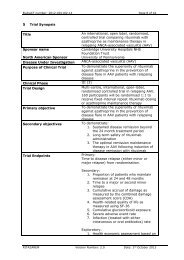Clinical Trial Design Issues and Options for the Study of Rare Diseases
Download Slides - Rare Disease
Download Slides - Rare Disease
- No tags were found...
Create successful ePaper yourself
Turn your PDF publications into a flip-book with our unique Google optimized e-Paper software.
<strong>Clinical</strong> <strong>Trial</strong> <strong>Design</strong><strong>Issues</strong> <strong>and</strong> <strong>Options</strong><strong>for</strong> <strong>the</strong> <strong>Study</strong> <strong>of</strong> <strong>Rare</strong> <strong>Diseases</strong>Jeffrey Krischer, Ph.D.Data Management <strong>and</strong> Coordination Center<strong>Rare</strong> <strong>Diseases</strong> <strong>Clinical</strong> Research NetworkOctober 2, 2012
• NoneFinancial Disclosure
The Issue The Implication• Few patients.• Few patients.• Few patients.• Few patients.• Multi-site studies.• Difficulty getting drugs<strong>for</strong> limited indications.• Longer studies.• Limited design options<strong>for</strong> clinical trials.
The Basic Issue• To test efficacy, need a control group.• Choices: literature control, historical controls,concurrent controls, patients as own controls.• Typical design is to recruit/assign to a treatmentgroup/observe each group <strong>and</strong> compareoutcomes.• BuBut what if you could design astudy using <strong>the</strong> same patient morethan once?
Possible <strong>Design</strong> <strong>Options</strong>• Parallel group design• Cross-over design• Factorial design• Historical controls design• R<strong>and</strong>omized withdrawal design• Early escape design• n-<strong>of</strong>-1 design• Group sequential design• Case-Control design• Prospective cohort design• Decision analysis-based design• Ranking <strong>and</strong> selection design• Adaptive design• Risk-based allocation design• Bayesian designs• Enhanced designsReduce <strong>the</strong> number <strong>of</strong>study subjects neededby using enrolled subjectsmore than once.
Crossover <strong>Design</strong>sA1A2Difficulty getting drugs <strong>for</strong> limited indications.B1B2washoutTime
Crossover <strong>Design</strong>sA1A2Difficulty getting drugs <strong>for</strong> limited indications.B1B2A1+A2 vs. B1+B2
Crossover <strong>Design</strong> Analysis
Treatment Effects
Carryover Effects
Using Crossover <strong>Design</strong>s• Chronic condition.• Relatively short study period.• No carryover effect expected.
Advantages <strong>and</strong> Limitations• Advantages:• Doubles <strong>the</strong> effective sample size.• Limitations:• <strong>Study</strong> takes twice as long.• Refusal bias.• Carryover effects make interpreting studyvery complex.
Factorial <strong>Design</strong>sCADifficulty getting drugs <strong>for</strong> limited indications.BDCDTime
Factorial <strong>Design</strong> AnalysisA+C + A+D vs. B+C + B+D<strong>and</strong>C+A + C+B vs. D+A + D+B
Factorial <strong>Design</strong> Analysis
Example <strong>of</strong> an InteractionA active , B active : 60% successA active , B placebo : 30% successA placebo , B active : 30% successA placebo , B placebo : 30% success
InteractionsAABBCD
Placebo Controlled Experiments(B <strong>and</strong> D are placebo)If both questions are placebo controlled, <strong>the</strong>nA C A+C PlaceboSecondary comparison <strong>of</strong> combined effects
Advantages <strong>and</strong> Limitations• Advantages:• Doubles <strong>the</strong> effective sample size, <strong>and</strong> it ispossible <strong>for</strong> <strong>the</strong> treatments to runconcurrently.• Limitations:• <strong>Study</strong> could take twice as long.• Refusal bias.• Interaction effects make interpretingstudy very complex.
N-<strong>of</strong>-1 R<strong>and</strong>omized <strong>Trial</strong> <strong>Design</strong>ABBAABDrug <strong>and</strong> placebo administeredsequentially in a r<strong>and</strong>omsequence, generally 3 or moredrug-placebo pairs.
N-<strong>of</strong>-1 R<strong>and</strong>omized <strong>Trial</strong> <strong>Design</strong>• If patient’s response was poor, that treatmentstopped <strong>and</strong> <strong>the</strong> next treatment in <strong>the</strong> sequencebegun immediately without breaking <strong>the</strong>r<strong>and</strong>omized sequence.• At <strong>the</strong> end <strong>of</strong> <strong>the</strong> study, <strong>the</strong> mean values <strong>for</strong> allmeasures <strong>and</strong> <strong>the</strong> mean differences betweentreatments are computed.
n-<strong>of</strong>-1 R<strong>and</strong>omized <strong>Trial</strong>• Disorder should be chronic, i.e. relativelyunchanging.• Treatment effect rapid.• Treatment duration <strong>for</strong> optimal effect should bewell known.
Advantages <strong>and</strong> Limitations• Advantages:• Every patient receives every treatment.• Treatment is evaluated in each patient.• Limitations:• <strong>Study</strong> could take very long.• Refusal bias.• Difficult to know whe<strong>the</strong>r design assumptionsare met (duration <strong>of</strong> treatment <strong>for</strong>optimal effect ).
Enhanced <strong>Trial</strong> <strong>Design</strong>sUsing patients more than once,but using <strong>the</strong> trial itself to select which group tore-use.
. Conventional designR<strong>and</strong>omizeTreatmentPhase 11 2ActiveTreatmentPlaceboResultsResponderNonResponderResponderNonResponderEfficacy analysis is based on comparing <strong>the</strong>results <strong>of</strong> <strong>the</strong> two treatment arms
Sample Size Required <strong>for</strong> a Given PowerResponse rateDrug Placebo DifferenceSingle Phase <strong>Design</strong> 60% 45% 15%Total nPower70%80%90%SinglePhase <strong>Design</strong>274346462
Single Enhanced <strong>Design</strong>R<strong>and</strong>omizeTreatmentPhase 11 2ActiveTreatmentPlaceboResultsResponderNonResponderResponderNonResponderR<strong>and</strong>omizeTreatmentPhase 23 4ActiveTreatmentPlacebo
Comparison <strong>of</strong> Sample Size Required <strong>for</strong>a Given PowerResponse rateDrug Placebo DifferenceSingle Phase <strong>Design</strong> or SPCD Phase 1 60% 45% 15%SPCD Phase 2 50% 25% 25%1.6XPower70%80%90%Total nSinglePhase <strong>Design</strong>274346462SPCD157199266
Comparison <strong>of</strong> Sample sizes between Parallel <strong>and</strong> SPDdesigns <strong>for</strong> three scenarios with low placebo response rate.Stage 1 Stage 2 Parallel SPDDrug Pbo Drug Pbo n nScenario 1 .40 .20 .30 .10 164 101Scenario 2 .30 .15 .20 .05 242 134Scenario 3 .25 .10 .20 .05 200 116All calculations are based on two-tailed alpha = 0.05, 80% power. For<strong>the</strong> SPD, <strong>the</strong> estimates are based on a 2:1 initial allocation <strong>of</strong>placebo:drug, <strong>and</strong> assumed retention <strong>of</strong> placebo patients from Stage 1to Stage 2 = 90%.
<strong>Issues</strong>• 2 chances to receive <strong>the</strong> active agent.• <strong>Study</strong> takes at least twice as long.• Efficiency depends upon response rate <strong>of</strong> thosereceiving placebo (placebo effect)• Savings in sample size since all patients areused once <strong>and</strong> some are used twice.
. Conventional designR<strong>and</strong>omizeTreatmentPhase 11 2ActiveTreatmentPlaceboResultsResponderNonResponderResponderNonResponder
Double Enhanced <strong>Design</strong>R<strong>and</strong>omizeTreatmentPhase 11ActiveTreatment2PlaceboResultsResponderR<strong>and</strong>omize5 6ActiveTreat PlacebomentNonResponderTreatmentPhase 2ResponderR<strong>and</strong>omize3 4ActiveTreatmentNonResponderPlacebo
Summary• When <strong>the</strong> number <strong>of</strong> study subjects is limited, itis possible to design studies that “re-use” <strong>the</strong>subjects enrolled to increase study power .• Such designs require a number <strong>of</strong> assumptionsthat may or may not be verifiable.• For some assumptions, it may be possible to test<strong>for</strong> <strong>the</strong>ir effect, but this is done after <strong>the</strong> studyconcludes <strong>and</strong> may complicate reporting <strong>and</strong>interpretation <strong>of</strong> results.• Analyses are more complex <strong>and</strong> require goodstatistical advice at <strong>the</strong> time <strong>the</strong> study is beingdesigned.
ReferencesTamura R., Huang X.: An examination <strong>of</strong> <strong>the</strong>efficiency <strong>of</strong> <strong>the</strong> sequential parallel design inpsychiatric clinical trials; <strong>Clinical</strong> <strong>Trial</strong>s 2007;4:309-317.Ivanova A., Qaqish B., Schoenfeld D.:Optimality, sample size <strong>and</strong> power calculations<strong>for</strong> <strong>the</strong> sequential parallel comparison design;Statistics in Medicine 2011; 30: 2793-2803.Tamura R., Xuang X., Boos D.: Estimation <strong>of</strong>Treatment Effect <strong>for</strong> <strong>the</strong> Sequential Parallel <strong>Design</strong>;Statistics in Medicine 2011; Accepted <strong>for</strong>publication.Power calculator <strong>for</strong> a Sequential Parallel <strong>Design</strong> | MGHBiostatistics Center
References• Guyatt, GH, Sackett DL, Adachi, JD, et al. Aclinician’s guide <strong>for</strong> conducting r<strong>and</strong>omized trialsin individual patients. Can Med Assoc j. 1988;139:497-503.
Thank You









